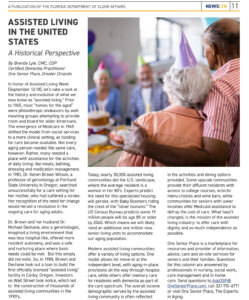
 By Brenda Lyle, CMC, CDP
By Brenda Lyle, CMC, CDP
Certified Dementia Practitioner
One Senior Place, Greater Orlando
In honor of Assisted Living Week (September 12-18), let’s take a look at the history and evolution of what we now know as “assisted living.” Prior to 1965, most “homes for the aged” were philanthropic endeavors by well-meaning groups attempting to provide room and board for older Americans. The emergence of Medicare in 1965 shifted the model from social services to a more clinical setting, as funding for care became available. Not every aging person was in need of the same care, however. Rather, many were in need of a place with assistance for the activities of daily living; like meals, bathing, dressing and medication management. In 1981, Dr. Keren Brown Wilson, a professor of gerontology at Portland State University in Oregon, searched unsuccessfully for a care setting for her mother, who had suffered a stroke. Her recognition of the need for change would herald a revolution in the ongoing care for aging adults.
Dr. Brown and her husband Dr. Michael Deshane, also a gerontologist, imagined a living environment that was less hospital-like, offered more resident autonomy, and was a safe and nurturing place where basic needs could be met. But this simply did not exist. So, in 1988, Brown and Deshane took out a loan to build the first officially licensed “assisted living” in Canby, Oregon. Investors on Wall Street took notice, leading to the construction of thousands of assisted living communities in the 1990’s.
Today, nearly 30,000 assisted living communities dot the U.S. landscape, where the average resident is a woman in her 80’s. Experts predict the need for this specialized housing will persist, with Baby Boomers riding the crest of the “silver tsunami.” The US Census Bureau predicts some 19 million people will be aged 85 or older by 2060. Which means we will likely need an additional one million new senior living units to accommodate our aging population.
Modern assisted living communities offer a variety of living options. One model allows for move-in at the independent level, with aging-in-place provisions all the way through hospice care. Many offer memory care for residents with dementia as part of the care spectrum. The overall income demographic served by the assisted living community is reflected in the dining and activities options. Some upscale communities provide their affluent residents with access to college courses, eclectic menu choices and wine bars. While communities for lower income seniors offer Medicaid assistance to defray the cost of care. What hasn’t changed is the mission of the assisted living industry: to offer care with dignity and as much independence as possible.
One Senior Place is a marketplace for resources and provider of information, advice, care and on-site services for seniors and their families. Questions for this column are answered by professionals in nursing, social work, care management and in-home care. Send questions to AskOSP@OneSeniorPlace.com, call 321-751-6771 or visit One Senior Place, The Experts in Aging.


